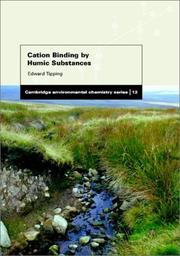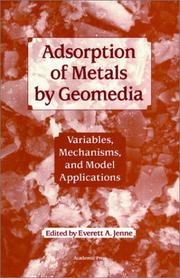| Listing 1 - 2 of 2 |
Sort by
|

ISBN: 1107114802 1280429399 9786610429394 0511176600 0511039972 0511157495 0511329687 0511535597 0511050380 9780511039973 9780511535598 6610429391 0521621461 9780521621465 0521675650 9780521675659 Year: 2002 Publisher: New York Cambridge University Press
Abstract | Keywords | Export | Availability | Bookmark
 Loading...
Loading...Choose an application
- Reference Manager
- EndNote
- RefWorks (Direct export to RefWorks)
Humic substances are highly-abundant organic compounds formed in soils and sediments by the decay of dead plants, microbes and animals. This book focuses on the important binding properties of these compounds which regulate the chemical reactivity and bioavailability of hydrogen and metal ions in the natural environment. Topics covered include the physico-chemical properties of humic matter and interactions of protons and metal cations with weak acids and macromolecules. Experimental laboratory methods are also discussed, together with mathematical modelling. Finally the author looks at how the results of this research can be used to interpret environmental phenomena in soils, waters and sediments. This comprehensive account of cation binding by humic matter is a valuable resource for advanced undergraduate and graduate students, environmental scientists, ecologists and geochemists.
Humic acid --- Cations. --- Ligand binding (Biochemistry) --- Binding, Ligand (Biochemistry) --- Biochemistry --- Dye-ligand affinity chromatography --- Radioligand assay --- Positive ions --- Ions --- Organic acids --- Derivatives. --- Mathematical models. --- Cations --- 631.413.4 --- 631.416.8 --- 631.417.2 --- 631.417.2 Humus content --- Humus content --- 631.416.8 Metals and their compounds. Heavy metals in soil --- Metals and their compounds. Heavy metals in soil --- 631.413.4 Cation exchange --- Cation exchange --- Derivatives --- Mathematical models

ISBN: 012384245X 9786611025946 1281025941 008049868X 9780080498683 9780123842459 Year: 1998 Publisher: San Diego : Academic Press,
Abstract | Keywords | Export | Availability | Bookmark
 Loading...
Loading...Choose an application
- Reference Manager
- EndNote
- RefWorks (Direct export to RefWorks)
Adsorption of Metals by Geomedia, serves as a needed resource for this topic which has received much attention during the past 15 years. The book provides an in-depth review of the field, followed by numerouschapters that document the current status of adsorption research for a variety of metals by geomedia ranging from individual minerals to sediments and soils. Adsorption mechanisms are detailed and precipitation is presented as a distinct sorption process.Virtually all factors affecting the extent of metal adsorption are examined, including the effects of selected anions, competition
Geochemistry --- Metals --- Soil absorption and adsorption --- Géochimie --- Absorption and adsorption --- 631.414.3 --- 631.416.8 --- -Soil absorption and adsorption --- #ABIB:acol --- Absorption in soils --- Adsorption in soils --- Soil absorption --- Soil adsorption --- Soil sorption --- Sorption, Soil --- Soil chemistry --- Soil permeability --- Soil physics --- Metallic elements --- Chemical elements --- Ores --- Metallurgy --- Chemical composition of the earth --- Chemical geology --- Geological chemistry --- Geology, Chemical --- Chemistry --- Earth sciences --- Absorption. Adsorption --- Metals and their compounds. Heavy metals in soil --- 631.416.8 Metals and their compounds. Heavy metals in soil --- 631.414.3 Absorption. Adsorption --- Géochimie --- Molybdenum. --- Nickel. --- Metals. --- Strontium. --- HUMIC SUBSTANCES --- GIBBSITE --- EXAFS --- Sand. --- Adsorption. --- Septanium --- CLAYS --- Citric acid. --- Data treatment --- Modeling. --- Lead. --- MODELLING --- PB --- Cadmium. --- Goethite. --- Cesium. --- Kaolinite. --- Solids. --- Uranium. --- Groundwater. --- Aluminum. --- Ferihydrite --- Copper. --- Native element minerals --- Transition metals --- Aluminium --- Group 13 elements --- Light metals --- Ground water --- Subterranean water --- Underground water --- Water, Underground --- Water --- Hydrogeology --- Actinide elements --- Transuranium elements --- Solid state physics --- Transparent solids --- Clay minerals --- Caesium --- Alkali metals --- Allcharite --- Gothite --- Xanthosiderite --- Hydroxide minerals --- Group 14 elements --- Clay modeling --- Modelling --- Molding (Clay, plaster, etc.) --- Clay --- Sculpture --- Carboxylic acids --- Sorption --- Separation (Technology) --- Surface chemistry --- Quartz sand --- Aggregates (Building materials) --- Sediments (Geology) --- Alkaline earth metals --- Chromium group --- Technique --- Monograph --- Geochemistry. --- Soil absorption and adsorption. --- Absorption and adsorption.
| Listing 1 - 2 of 2 |
Sort by
|

 Search
Search Feedback
Feedback About UniCat
About UniCat  Help
Help News
News